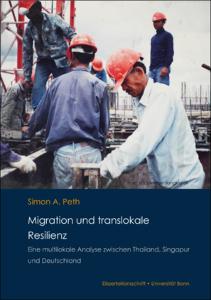Rana, Md. Sohel: Temporary migration: Characteristics, livelihood effects, and destination choices in northern rural Bangladesh. - Bonn, 2025. - Dissertation, Rheinische Friedrich-Wilhelms-Universität Bonn.
Online-Ausgabe in bonndoc: https://nbn-resolving.org/urn:nbn:de:hbz:5-82707
Online-Ausgabe in bonndoc: https://nbn-resolving.org/urn:nbn:de:hbz:5-82707
@phdthesis{handle:20.500.11811/13075,
urn: https://nbn-resolving.org/urn:nbn:de:hbz:5-82707,
author = {{Md. Sohel Rana}},
title = {Temporary migration: Characteristics, livelihood effects, and destination choices in northern rural Bangladesh},
school = {Rheinische Friedrich-Wilhelms-Universität Bonn},
year = 2025,
month = may,
note = {Temporary migration is common in poor agrarian economies but remains largely under-researched. While this migration is weaker in reducing poverty than longer-term migration, the reasons many poor rural households continue to prefer temporary migration are inadequately explored in the literature. Similarly, while migration theories often emphasize income-driven migration from rural origins to urban destinations, the preference for rural destinations among many temporary migrants also remains unclear. Employing a mixed-method approach, this study addresses these two key questions in northern rural Bangladesh, contributing to the emerging literature on temporary migration in poor agrarian economies. A qualitative methodology is used to conceptualize temporary migration and destination decision-making, while these insights are further explored through quantitative data from over 800 household surveys and relevant econometric models.
The findings reveal that farm labor constraints and family obligations limit longer-term migration, making temporary migration a viable alternative for risk diversification in the less-diversified local economy. For poor rural households, temporary migration is crucial for improving food consumption and dietary quality during agricultural lean periods, despite its relatively limited effects on overall household income compared to longer-term migration. Additionally, constrained, poor households often favor rural destinations for temporary migration, which offer a better income-to-cost ratio and allow short-duration mobility without exacerbating their existing constraints at home. By contrast, urban destinations, while associated with higher remittance potential, pose greater costs and risks, making them less viable for these households.
The study highlights the importance of supporting temporary migration as a critical risk mitigation strategy in poor agrarian contexts. Policy measures such as improving access to wage information, reducing search costs, and enhancing inter-district transportation networks could facilitate temporary migration, particularly to rural destinations, thereby improving the welfare of a significant portion of poor agrarian societies. These measures could not only benefit migrating households but also help address farm labor shortages in labor-intensive agricultural regions. Additionally, the study calls for further research into the effects of temporary migration on agricultural production in destination rural areas and the implications of farm mechanization for the livelihoods of rural-bound temporary migrant households.},
url = {https://hdl.handle.net/20.500.11811/13075}
}
urn: https://nbn-resolving.org/urn:nbn:de:hbz:5-82707,
author = {{Md. Sohel Rana}},
title = {Temporary migration: Characteristics, livelihood effects, and destination choices in northern rural Bangladesh},
school = {Rheinische Friedrich-Wilhelms-Universität Bonn},
year = 2025,
month = may,
note = {Temporary migration is common in poor agrarian economies but remains largely under-researched. While this migration is weaker in reducing poverty than longer-term migration, the reasons many poor rural households continue to prefer temporary migration are inadequately explored in the literature. Similarly, while migration theories often emphasize income-driven migration from rural origins to urban destinations, the preference for rural destinations among many temporary migrants also remains unclear. Employing a mixed-method approach, this study addresses these two key questions in northern rural Bangladesh, contributing to the emerging literature on temporary migration in poor agrarian economies. A qualitative methodology is used to conceptualize temporary migration and destination decision-making, while these insights are further explored through quantitative data from over 800 household surveys and relevant econometric models.
The findings reveal that farm labor constraints and family obligations limit longer-term migration, making temporary migration a viable alternative for risk diversification in the less-diversified local economy. For poor rural households, temporary migration is crucial for improving food consumption and dietary quality during agricultural lean periods, despite its relatively limited effects on overall household income compared to longer-term migration. Additionally, constrained, poor households often favor rural destinations for temporary migration, which offer a better income-to-cost ratio and allow short-duration mobility without exacerbating their existing constraints at home. By contrast, urban destinations, while associated with higher remittance potential, pose greater costs and risks, making them less viable for these households.
The study highlights the importance of supporting temporary migration as a critical risk mitigation strategy in poor agrarian contexts. Policy measures such as improving access to wage information, reducing search costs, and enhancing inter-district transportation networks could facilitate temporary migration, particularly to rural destinations, thereby improving the welfare of a significant portion of poor agrarian societies. These measures could not only benefit migrating households but also help address farm labor shortages in labor-intensive agricultural regions. Additionally, the study calls for further research into the effects of temporary migration on agricultural production in destination rural areas and the implications of farm mechanization for the livelihoods of rural-bound temporary migrant households.},
url = {https://hdl.handle.net/20.500.11811/13075}
}









